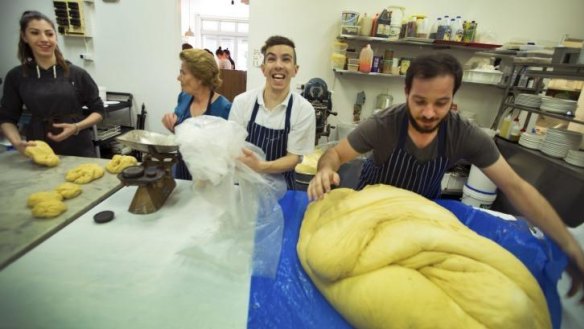Greek bakers set cracking pace at Easter

While other teens take a break, 16-year-old Lola Laliotis is spending her Easter school holidays working flat-out, helping make the Greek sweet bread, tsoureki, at her father's bakery. But it's where she wants to be.
Greek Easter Sunday this year is April 12, a week after non-Orthodox Easter. For up to 16 hours a day until Saturday April 11, the families and staff of Peter Laliotis and Andrew Kantaras, owners of Hellas Cakes, will rally to make 5000 tsourekia - the plural word for the circular, plaited breads.
"I reckon it's really important to help out family, especially during Easter when it's really, really busy," Lola says. For Greek-Australians, "when you think about Easter, you think about tsoureki".
Hellas Cakes' tsourekia will be trucked to shops as far away as the Northern Territory, and 1200 will be sold here at their Lennox Street bakery.
Hellas Cakes was founded in 1962 by immigrant Hraklis Kenos. In 1970, he took on Mr Laliotis' father, experienced pastry chef George Laliotis, as a business partner. In 1977, after Mr Kenos left to start a confectionary business, employee George Kantaras became a partner.
Now the sons of "the two Georges" run the business, and although Richmond is no longer Melbourne's Greek hub, former locals come from all over town, and non-Greeks have embraced pastries such as baklava and spanakopita.
It's just as well that tsourekia are made once a year because one batch can take eight hours to create.
First, the dough including butter, sugar, eggs, flour, yeast and the spice mahlepi is mixed in Mr Kanos' rattling 80-year-old mixer.
The mixture is left to ferment for up to four hours, weighed into half-kilo and 1kg portions, laid out in long strands then plaited and shaped into circles. One of the trickiest parts is throwing and twisting the plaited dough so the join doesn't show.
Placed in a prover to steam for 30 to 40 minutes, the tsourekia rise to twice their size.
It is Lola's role to place the half-boiled egg in the centre of each tsoureki, glaze the bread with egg and sprinkle it with flaked almonds before the tsourekia are baked 20-30 minutes in the oven.
Mr Laliotis says the finished tsourekia should be shiny golden brown, light and evenly plaited.
And how do they bake those red eggs in the centre of the dough, without the egg exploding?
Mr Laliotis says he first half-boils the eggs in red dye, and keeps them at room temperature so they won't crack when placed in the warm dough.
The red egg symbolises the resurrected Christ.
After the Laliotis family attends April 11 Easter midnight mass, they will bring a candle home, which forms a centrepiece with the tsourekia over post-midnight dinner of tripe soup. They then eat the tsourekia and each crack an egg against someone else's egg and declare "Christos Anesti", (Christ is Risen). Children have a game where the one whose egg cracks first is the loser.
On Easter Sunday morning, Mr Laliotis says, his father, George, 78, will be up by 6am to fire up the lamb spit at his Northcote house, and the family lunch will last all day. "After that I'll probably sleep for two days," he said.
Restaurant reviews, news and the hottest openings served to your inbox.
Sign up